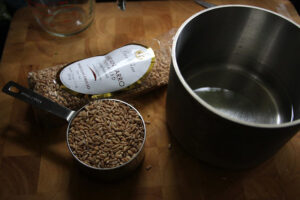FARRO

A new study has shown how a modified Mediterranean diet (‘Med-plus’) was able to match a well formulated low carbohydrate keto diet in achieving significant improvement in blood glucose levels in people with type 2 diabetes and prediabetes (1). And the Med-plus diet did better in reducing cardiometabolic risk factors and improving nutrient intakes. Both eating patterns encouraged vegetables, restricted added sugars and limited refined grains but the ‘Med-plus’ included legumes, fruits and intact whole grains that were not included on the keto-diet. The Med-plus diet was also found to be more behaviourally sustainable (and likely to be more environmentally sustainable as well although this aspect was not examined). One of the intact whole grain foods on the menu was farro. So, what is farro and how can we all enjoy the health benefits?
Farro is the grain from several wheat species: emmer (small sized grains), einkorm (medium sized) or spelt (large sized grains) and is often termed an ‘ancient grain’ as it originated in Mesopotamia (the present day Middle-east) and is nicknamed “the pharoah’s wheat”. It is a traditional ingredient in Tuscan cuisine where it made into risotto and soup. It is purchased dried and must be boiled until soft, but it holds its shape and retains a chewy texture. It has a nutty flavour and is a little sweet. It can be enjoyed warm as a side dish in mixed dishes, or cold in salads, much like rice or pasta. Like barley, farro can be purchased in a pearled form (with the outer layer removed and therefore cooks faster), as whole-grain or whole-berry farro, or semi-pearled. Whole-grain farro should ideally be soaked overnight and boiled for around 40 minutes, whereas pearled and semi-pearled farro don’t need pre-soaking and cook in around 15-30 minutes. In a culinary sense, farro is a chewy, nutty canvas onto which you can layer the ingredients and flavours you want, and provides a satisfying starchy base to which you can add vegetables, meat, poultry, fish or legumes for a balanced meal. There are plenty of recipes online.
There is only one figure for glycemic index (GI) in the international tables and that is 63 (medium) for pearled farro. You might expect unpearled farro to be slightly lower due to its higher fibre content and intact bran layer. Serving farro in a healthy mixed meal with some lean protein, healthy fats, vegetables and perhaps a few nuts would slow down the rate of carbohydrate absorption even further.
Farro is highly nutritious: high in fibre, protein, vitamins, minerals and phytochemicals including antioxidants. While the unpearled, whole-berry farro is harder to find it does offer extra fibre and nutrients but if you can’t find it, even the pearled version is nutrient-rich and has a good amount of fibre. A serving size is around ½ cup of dry farro (85g). Look for farro in wholefood stores or online.
Nutrition Information for dried farro per 100g, variety of brands:
| Variety | Spelt, uncooked (100g) |
Pearled farro (farro perlato) (100g) |
Italian farro (100g) | Organic farro (100g) |
| Energy | 1315kJ (314cal) |
1507kJ (360cal) |
1647kJ (400cal) |
1612kJ (385cal) |
| Protein | 11.7g | 10g | 13.3g | 13.5g |
| Carbohydrate | 59.2g | 74g | 77.8 | 71.2g |
| – Sugars | 1.4g | 0g | 0g | 0g |
| Fats, total | 3g | 3g | 2.22g | 2.88g |
| – Saturated | 0.36g | 0g | 0g | 0g |
| Fibre | 8.8g | 10g | 6.7g | 13.5g |
- Gardner, and colleagues. Effect of a ketogenic diet versus Mediterranean diet on glycated hemoglobin in individuals with prediabetes and type 2 diabetes mellitus: The interventional Keto-Med randomized crossover trial. The American Journal of Clinical Nutrition, 2022

Nicole Senior is an Accredited Practising Dietitian, author, consultant, cook and food enthusiast who strives to make sense of nutrition science and delights in making healthy food delicious.
Contact: You can follow her on Twitter, Facebook, Pinterest, Instagram or check out her website







